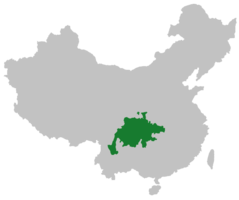Sichuanese Pinyin
Sichuanese Pinyin (Si4cuan1hua4 Pin1yin1; simplified Chinese: 四川话拼音; traditional Chinese: 四川話拼音; pinyin: Sìchuānhuà pīnyīn), is a romanization system specifically designed for the Chengdu dialect of Sichuanese. It is mostly used in selected Sichuanese dictionaries, such as the Sichuan Dialect Dictionary,[1] Sichuan Dialect's Vocabulary Explanation,[2] and the Chengdu Dialect Dictionary.[3] Sichuanese Pinyin is based on Hanyu Pinyin, the only Chinese romanization system officially instructed within the People's Republic of China, for convenience amongst users. However, there is also the problem that it is unable to match the phonology of Sichuanese with complete precision, especially in the case for the Minjiang dialect, as there are many differences between Sichuanese and Standard Chinese in phonology.
| Chinese romanization |
|---|
| Mandarin |
|
Sichuanese |
| Wu |
| Yue |
| Min |
| Gan |
|
Chang-Du dialect |
| Hakka |
| Xiang |
|
Chang–Yi dialects |
| See also |
|
Other transliterations |
Scheme
Initials
Below each IPA symbol in the table below are the letters which correspond to their respective sounds in Sichuanese Pinyin, and a sample Chinese character with that initial:
| Bilabial | Labiodental | Coronal | Alveolar | alveopalatal | Velar | ||
|---|---|---|---|---|---|---|---|
| Plosive | plain | [p] b 贝 |
[t] d 得 |
[k] g 古 | |||
| aspirated | [pʰ] p 配 |
[tʰ] t 套 |
[kʰ] k 可 | ||||
| Affricate | plain | [ts] z 早 |
[tɕ] j 价 |
||||
| aspirated | [tsʰ] c 草 |
[tɕʰ] q 巧 |
|||||
| Nasal | [m] m 没 |
[n] n 路 |
[nʲ] ny 你 |
[ŋ] ng 我 | |||
| Fricative | Voiceless | [f] f 发 |
[s] s 速 |
[ɕ] x 小 |
[x] h 好 | ||
| voiced | [v] v 五 |
[z] r 如 |
|||||
| Zero | ∅ 儿 | ||||||
Finals
Below each IPA symbol in the table below are the letters which correspond to their respective sounds in Sichuanese Pinyin, and a sample Chinese character with that syllable rime:
| -Ø | -i or -u | nasal finals | |||||||||||
|---|---|---|---|---|---|---|---|---|---|---|---|---|---|
| Ø- | [z] i 日 |
[ɚ] er 二 |
[a] a 大 |
[o] o 我 |
[ɛ] e 黑 |
[ai] ai 街 |
[ei] ei 批 |
[au] ao 包 |
[əu] ou 走 |
[an] an 烦[4] |
[ən] en 樱 |
[aŋ] ang 帮 |
[oŋ] ong 亩 |
| i- | [i] i 一 |
[ia] ia 牙 |
[iɛ] ie 叶 |
[iai] iai 介 |
[iau] iao 标 |
[iəu] iu 九 |
[ian] ian 变[4] |
[in] in 兵 |
[iaŋ] iang 量 |
||||
| u- | [u] u 五 |
[ua] ua 瓜 |
[uɛ] ue 国 |
[uai] uai 乖 |
[uei] ui 类 |
[uan] uan 段[4] |
[uən] un 春 |
[uaŋ] uang 光 |
|||||
| y- | [y] ü 鱼 |
[yo] üo 药 |
[ye] üe 绝 |
[yan] üan 鲜[4] |
[yn] ün 泳 |
[yoŋ] iong 蓉 | |||||||
Tones
The Sichuanese Pinyin system uses superscript numbers to mark the four tones of Chengdu dialect. The number is placed on the top right corner of every syllable, where "1" stands for the first tone, "2" stands for the second tone, and so forth.
Rules
The rules of Sichuanese Pinyin are based on those of Hanyu Pinyin.
Sample text
The following sample text is a selection of Sichuanese idioms in Sichuanese Pinyin, Scuanxua Ladinxua Xin Wenz (in Sichuanese) and Hanyu Pinyin (in Standard Mandarin pronunciation), for comparative purposes:
| Chinese characters | Sichuanese Pinyin | Scuanxua Ladinxua Xin Wenz | Hanyu Pinyin |
|---|---|---|---|
| 矮子过河,安(淹)了心。 | Ngai3zi3 go4 ho2, ngan1 no2 xin1. | Ngaaiz go ho, ngan lo xin. | Ǎizi guò hé, yān le xīn. |
| 足正不怕鞋歪。 | Juo2 zen4 bu2pa4 hai2 wai1. | Giuo zen bupa xai uai. | Zú zhèng búpà xié wāi. |
| 吃苞谷粑打哈欠,开黄腔。 | Ci2 bao1gu2ba1 da3 ho1hai1, kai1 huang2qiang1. | C baoguba daa xoxai, kai xuongqiang. | Chī bāogǔbā dǎ hāqiàn, kāi huángqiāng. |
| 猫抓糍粑,脱不到爪爪。 | Mer1 zua1 ci2ba1, to2 bu2dao3 zao3zao3. | Mer zua cba, to budao zaozao. | Māo zhuā cíbā, tuō bùdào zhuǎzhuǎ. |
References
- (in Chinese) 王文虎、张一舟、周家筠 (1987). 《四川方言词典》. 四川人民出版社. ISBN 7-220-00370-6.
- (in Chinese) 缪树晟 (1989). 《四川方言词语汇释》. 重庆出版社. ISBN 7-5366-0638-9.
- (in Chinese) 罗韵希、韋一心、冷玉龍 (1987). 《成都话方言词典》. 四川省社会科学院出版社. ISBN 7-80527-594-7.
- There is a trend within the Chengdu dialect where [æ] will replace [an].
